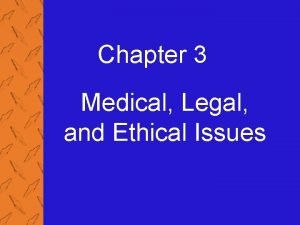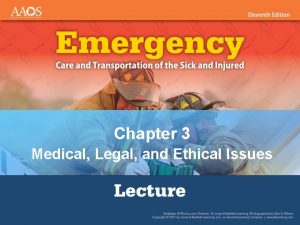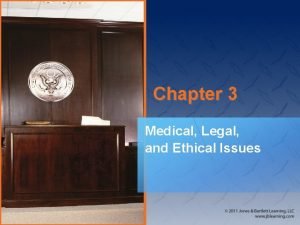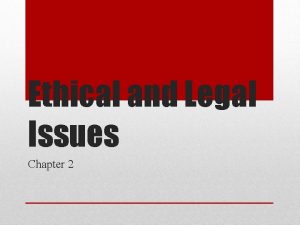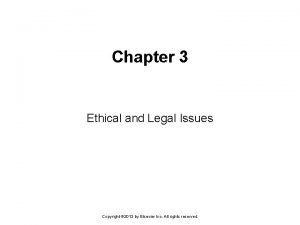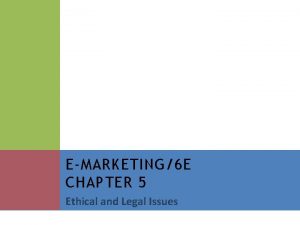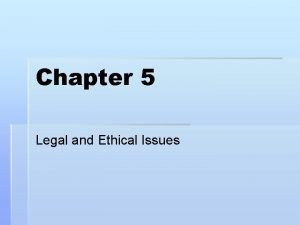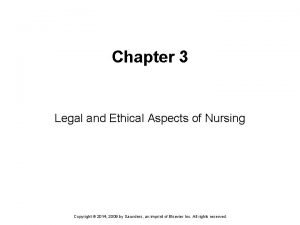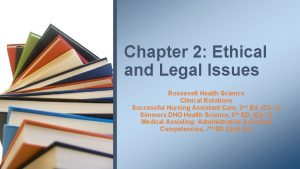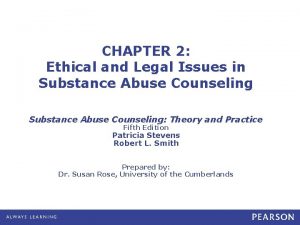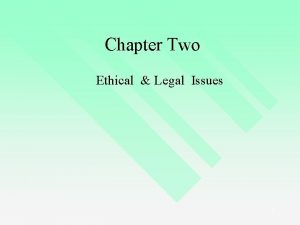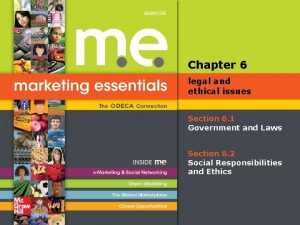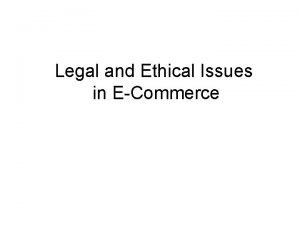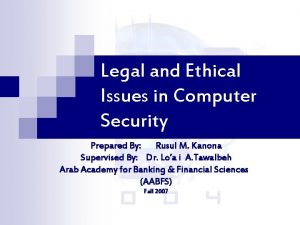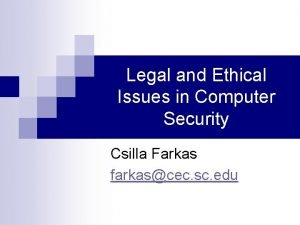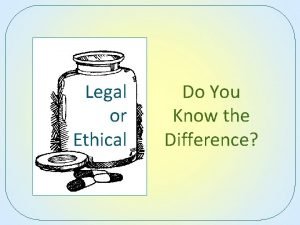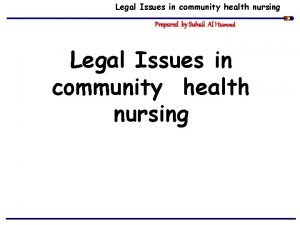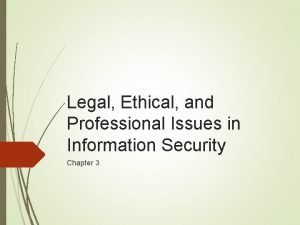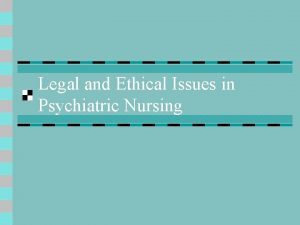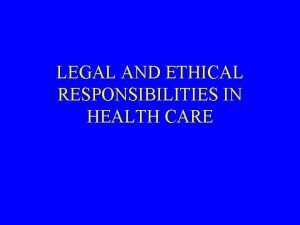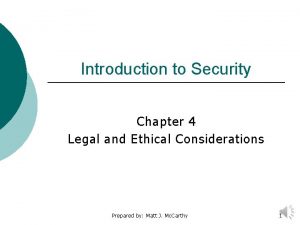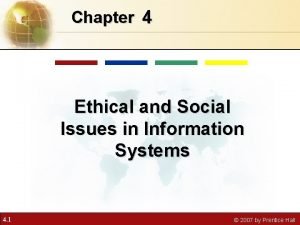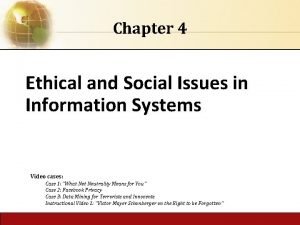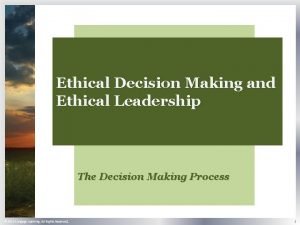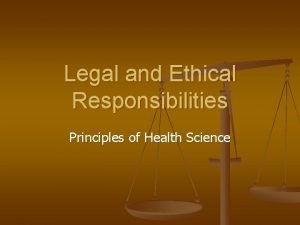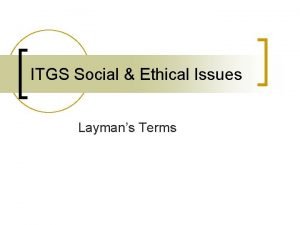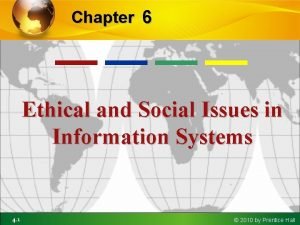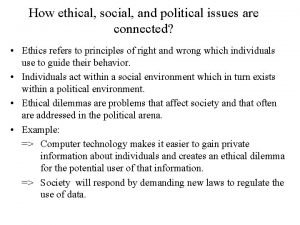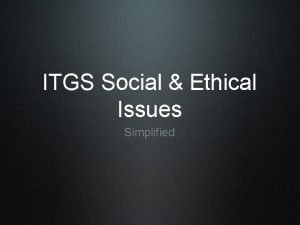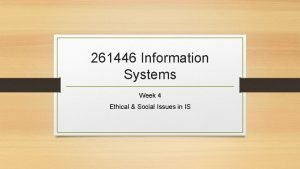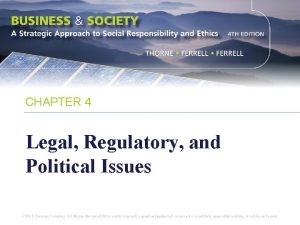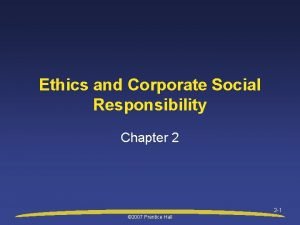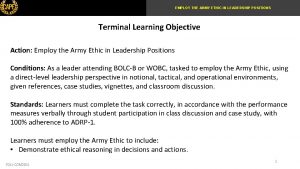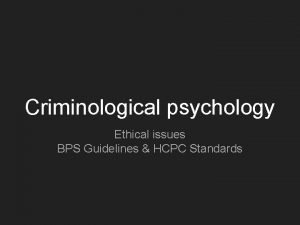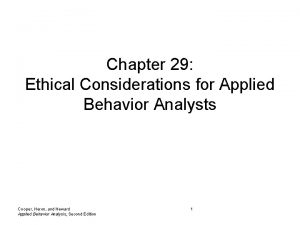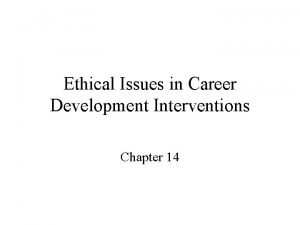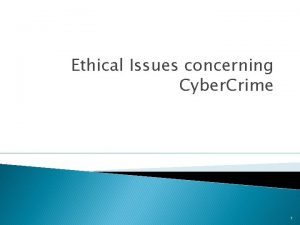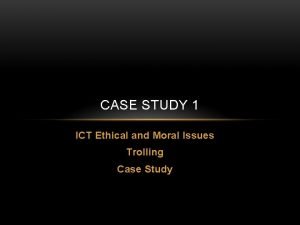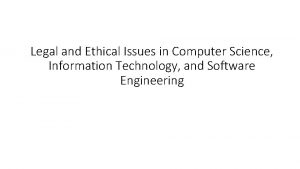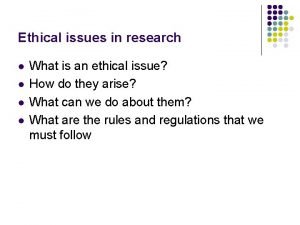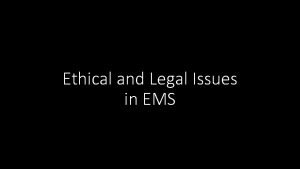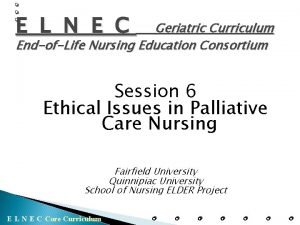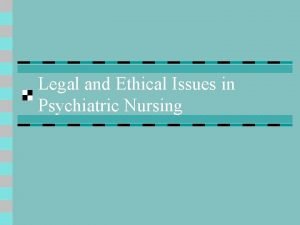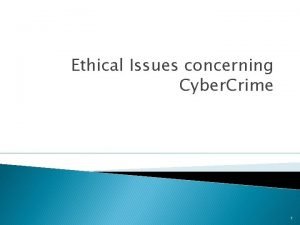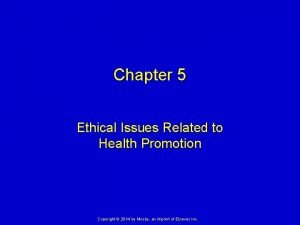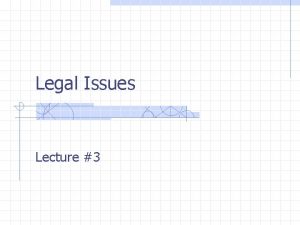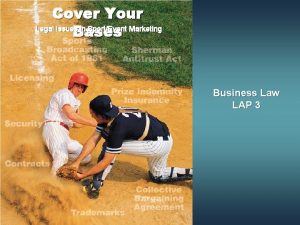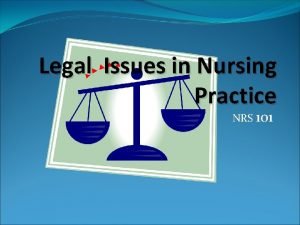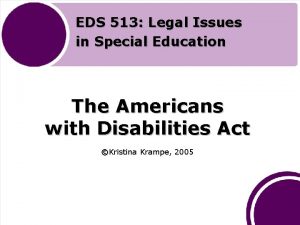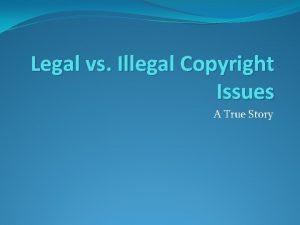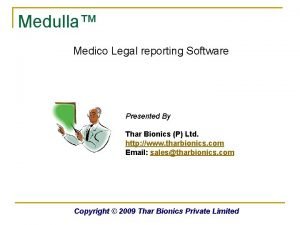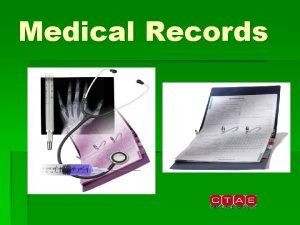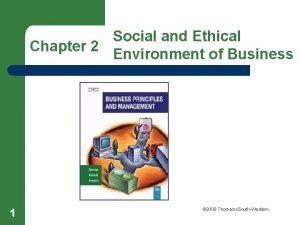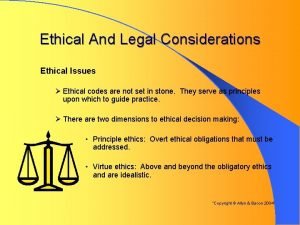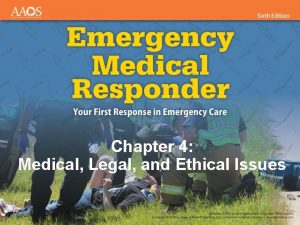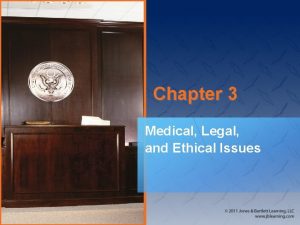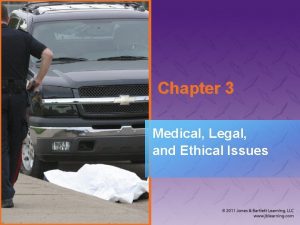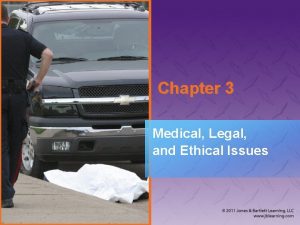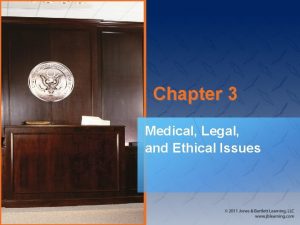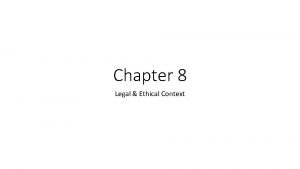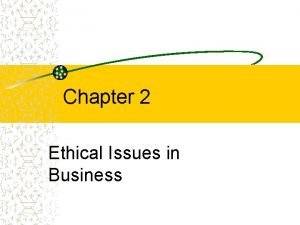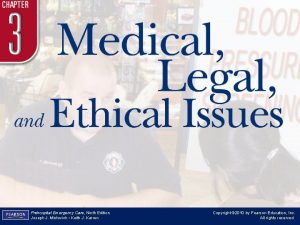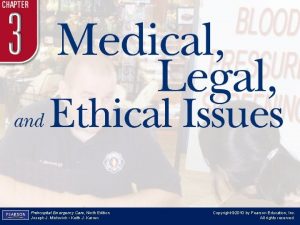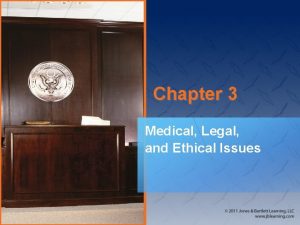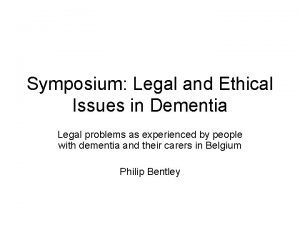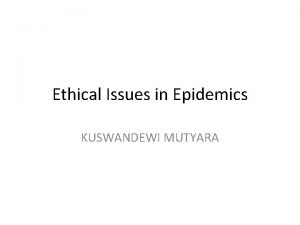Chapter 3 Medical Legal and Ethical Issues National








































































































- Slides: 104

Chapter 3 Medical, Legal, and Ethical Issues

National EMS Education Standard Competencies (1 of 3) Preparatory Applies fundamental knowledge of the emergency medical services (EMS) system, safety/well-being of the emergency medical technician (EMT), medical/legal, and ethical issues to the provision of emergency care.

National EMS Education Standard Competencies (2 of 3) Medical/Legal and Ethics • Consent/refusal of care • Confidentiality • Advance directives • Tort and criminal actions • Evidence preservation • Statutory responsibilities

National EMS Education Standard Competencies (3 of 3) Medical/Legal and Ethics (cont’d) • Mandatory reporting • Ethical principles/moral obligations • End-of-life issues

Introduction (1 of 2) • A basic principle of emergency care is to do no further harm. • A health care provider usually avoids legal exposure if he or she acts: – In good faith – According to an appropriate standard of care

Introduction (2 of 2) • The EMT is often the first link in the chain of prehospital care. • To avoid civil and criminal actions, provide competent emergency medical care that conforms with the standard of care.

Consent (1 of 2) • Consent is permission to render care. • A person must give consent for treatment. • If the patient is conscious and rational, he or she has a legal right to refuse care.

Consent (2 of 2) • Foundation of consent is decision-making capacity. – Can understand information provided – Can make informed choice regarding medical care • Patient autonomy is the right of the patient to make decisions about his or health.

Expressed Consent • The patient acknowledges he or she wants you to provide care or transport. • To be valid, the patient must provide informed consent. – You have explained the treatment, risks, and benefits to the patient.

Implied Consent (1 of 2) • Applies to patients who are – Unconscious – Otherwise incapable of making an informed decision © Murray Wilson/Fotolia. com.

Implied Consent (2 of 2) • Should never be used unless there is a threat to life or limb • Principle of implied consent is known as the emergency doctrine. • Good idea to get consent from a spouse or relative

Involuntary Consent • Applies to patients who are: – Mentally ill – In behavioral crisis – Developmentally delayed • Obtain consent from guardian – Not always possible, so understand local provisions

Minors and Consent (1 of 2) • Parent or legal guardian gives consent. • In some states, a minor can give consent. – Depending on age and maturity – Emancipated minors (married, armed services, parents) • Teachers and school officials may act in place of parents.

Minors and Consent (2 of 2) • If true emergency exists, and no consent is available: – Treat the patient. – Consent is implied. © Jones & Bartlett Learning. Courtesy of MIEMSS.

Forcible Restraint (1 of 2) • Sometimes necessary with combative patient • Legally permissible – Consult medical control © Jones and Bartlett Publishers. Courtesy of MIEMSS. – May require law enforcement

Forcible Restraint (2 of 2) • Know your local laws about forcible restraint. • If restraint is used: – Protect the patient’s airway. – Monitor the patient’s respiratory status.

The Right to Refuse Treatment (1 of 4) • Conscious, alert adults with decision-making capacity: – Have the right to refuse treatment – Can withdraw from treatment at any time, even if the result is death or serious injury • Places a burden on the EMT to clarify the need for treatment

The Right to Refuse Treatment (2 of 4) • Assess the patient’s ability to make an informed decision: – Ask and repeat questions. – Assess the patient’s answers. – Observe the patient’s behavior. • If the patient appears confused or delusional, you cannot assume that the decision to refuse is an informed refusal.

The Right to Refuse Treatment (3 of 4) • Suicidal patients should not be regarded as having normal mental capacity. • Providing treatment is a much more defensible position than failing to treat a patient. – Do not endanger yourself. – Use the assistance of law enforcement.

The Right to Refuse Treatment (4 of 4) • Before you leave a scene where a patient, parent, or caregiver has refused care: – Encourage the individual again to allow care. – Ask the individual to sign a refusal of care form. – A witness is valuable in these situations. – Document all refusals.

Confidentiality (1 of 3) • Confidential information includes: – Patient history – Assessment findings – Treatment provided • Information generally cannot be disclosed except: – If the patient signs a release – If a legal subpoena is presented – If it is needed by billing personnel

Confidentiality (2 of 3) • Health Insurance Portability and Accountability Act of 1996 (HIPAA) – Contains a section on patient privacy – Strengthens privacy laws – Safeguards patient confidentiality – Considers information to be protected health information (PHI)

Confidentiality (3 of 3) • You may be legally mandated to report your findings. – Release only the minimum amount of information necessary. • Failure to abide by the provisions of HIPAA laws can result in civil and/or criminal action.

Advance Directives (1 of 5) • An advance directive specifies treatment should the patient become unconscious or unable to make decisions. • A do not resuscitate (DNR) order is an advance directive that gives permission not to resuscitate. – “Do not resuscitate” does not mean “do not treat. ”

Advance Directives (2 of 5) • Other names for advance directives: – Living will – Health care directive • DNR orders must meet the following requirements: – Statement of the patient’s medical problem(s) – Signature of the patient or legal guardian – Signature of physician or health care provider – Not expired

Advance Directives (3 of 5) © Jones & Bartlett Learning.

Advance Directives (4 of 5) • Physician orders for life-sustaining treatment (POLST) and medical orders for lifesustaining treatment (MOLST): – Explicitly describe acceptable interventions for the patient – Must be signed by an authorized medical provider – Contact medical control for guidance

Advance Directives (5 of 5) • Some patients may have named surrogates to make decisions for them. – Durable powers of attorney for health care – Also known as health care proxies • Due to the growing number of hospice home health programs, you may face this situation.

Physical Signs of Death (1 of 4) • A physician determines the cause of death. • Presumptive signs of death: – Unresponsiveness to painful stimuli – Lack of a carotid pulse or heartbeat – Absence of breath sounds – No deep tendon or corneal reflexes

Physical Signs of Death (2 of 4) • Presumptive signs of death (cont’d): – Absence of eye movement – No systolic blood pressure – Profound cyanosis – Lowered or decreased body temperature

Physical Signs of Death (3 of 4) • Definitive signs of death: – A body in parts (decapitation) – Dependent lividity (blood settling) © American Academy of Orthopaedic Surgeons.

Physical Signs of Death (4 of 4) • Definitive signs of death (cont’d): – Rigor mortis (stiffening) – Putrefaction (decomposition)

Medical Examiner Cases (1 of 2) • Involvement depends on nature/scene of death. • Examiner notified in cases of: – Dead on arrival (DOA)/dead on scene (DOS) – Death without previous medical care – Suicide – Violent death – Poisoning, known or suspected

Medical Examiner Cases (2 of 2) • Examiner notified in cases of (cont’d): – Death from accidents – Suspicion of a criminal act – Infant and child deaths © Corbis.

Special Situations (1 of 4) • Organ Donors – Expressed a wish to donate their organs – Evidenced by information on: • Organ donor card and/or • Driver’s license – Your priority is to save the patient’s life. – Remember that organs need oxygen.

Special Situations (2 of 4) Courtesy of the US Department of Health and Human Services.

Special Situations (3 of 4) • Medical identification insignia – Bracelet, necklace, keychain, or card indicating: • DNR order • Allergies • Diabetes, epilepsy, or other serious condition • Some patients wear a medical bracelet with a USB flash drive. • Helpful in patient assessment and treatment

Special Situations (4 of 4) Courtesy of the Medic. Alert Foundation®. © 2006, All Rights Reserved. Medic. Alert® is a federally registered trademark and service mark.

Scope of Practice (1 of 2) • Outlines the care you are able to provide • Usually defined by state law • Medical director further defines by developing: – Protocols – Standing orders

Scope of Practice (2 of 2) • Carrying out procedures outside scope of practice may be considered: – Negligence – Criminal offense

Standards of Care (1 of 3) • Manner in which you must act or behave • You must be concerned about the safety and welfare of others. © Jones and Bartlett Publishers. Courtesy of MIEMSS.

Standards of Care (2 of 3) • Standards of care established by: – Local custom – Law • Statutes, ordinances, administrative regulation, or case law – Professional or institutional standards • Example: AHA CPR guidelines – Textbooks • Example: NHTSA

Standards of Care (3 of 3) • Standards of care established by (cont’d): – Standards imposed by states • Medical Practices Act • Certification • Licensure • Credentialing

Duty to Act • Individual’s responsibility to provide patient care • Duty to act applies: – Once your ambulance responds to a call – Once treatment is begun

Negligence (1 of 2) • Failure to provide same care that person with similar training would provide in same or similar situation

Negligence (2 of 2) • All four of the following elements must be present for negligence to apply: – Duty – Breach of duty – Damages – Causation

Abandonment • Unilateral termination of care by EMT without: – Patient’s consent – Making provisions for continuing care • Abandonment may take place: – At the scene – In the emergency department • Always obtain a signature on your patient care record

Assault and Battery, and Kidnapping (1 of 2) • Assault: unlawfully placing person in fear of immediate bodily harm – Example: restraint • Battery: unlawfully touching a person – Example: providing care without consent

Assault and Battery, and Kidnapping (2 of 2) • Kidnapping: seizing, confining, abducting, or carrying away by force – Example: transport against will – A false imprisonment charge is more likely (defined as unauthorized confinement of a person).

Defamation (1 of 2) • Communication of false information that damages reputation of a person – Libel: written – Slander: spoken

Defamation (2 of 2) • Defamation could happen with: – A false statement on a run report – Inappropriate comments made during conversation • The run report should be accurate, relevant, and factual.

Good Samaritan Laws and Immunity (1 of 2) • If you reasonably help another person, you will not be held liable for errors or omissions. • Good Samaritan conditions to be met: – Good faith – Without expectation of compensation – Within scope of training – Did not act in grossly negligent manner

Good Samaritan Laws and Immunity (2 of 2) • Gross negligence: conduct that constitutes willful or reckless disregard • There is another group of laws that grants immunity from liability to official providers. – Laws vary; always consult with the medical director.

Records and Reports (1 of 2) • Compile a record of all incidents involving sick or injured patients. • Important safeguard against legal complications • Courts consider: – An action not recorded was not performed. – Incomplete or untidy reports is evidence of poor emergency medical care.

Records and Reports (2 of 2) • National EMS Information System (NEMSIS) – Provides the ability to collect, store, and share standardized EMS data – Used to improve the speed and accuracy of data collection

Special Mandatory Reporting Requirements (1 of 3) • Most states have a reporting obligation: – Abuse of children, older persons, and others – Injury during commission of a felony – Drug-related injuries – Childbirth

Special Mandatory Reporting Requirements (2 of 3) • Most states have a reporting obligation (cont’d): – Attempted suicides – Dog bites – Communicable diseases – Assaults – Domestic violence

Special Mandatory Reporting Requirements (3 of 3) • Most states have a reporting obligation (cont’d): – Sexual assault or rape – Exposures to infectious disease – Transport of patients in restraints – Scene of a crime – The deceased

Ethical Responsibilities (1 of 2) • Ethics: philosophy of right and wrong, moral duties, and ideal professional behavior • Morality: code of conduct affecting character, conduct, and conscience. • Bioethics: specifically addresses issues that arise in the practice of health care

Ethical Responsibilities (2 of 2) • Require you to evaluate and apply ethical standards – Your own – Those of the profession • Be honest in reporting. • Keep accurate records.

The EMT in Court (1 of 6) • You can end up in court as: – A witness – A defendant • Case can be civil or criminal. © Brand X Pictures/Creatas.

The EMT in Court (2 of 6) • Whenever called to testify, notify: – Your service director – Legal counsel • As witness: – Remain neutral – Review run report before court

The EMT in Court (3 of 6) • As a defendant, an attorney is required. • Defenses may include: – Statute of limitations – Governmental immunity – Contributory negligence

The EMT in Court (4 of 6) • Discovery allows both sides to obtain more information through: – Interrogatories • Written requests or questions – Depositions • Oral requests or questions

The EMT in Court (5 of 6) • Most cases are settled following the discovery phase during the settlement phase. • If not settled, the case goes to trial • Damages that may be awarded: – Compensatory damages – Punitive damages

The EMT in Court (6 of 6) • Any EMT charged with a criminal offense should secure the services of a highly experienced criminal attorney immediately.

Review 1. You arrive at the scene of an older woman complaining of chest pain. In assessing her, she holds her arm out for you to take her blood pressure. This is an example of: A. B. C. D. implied consent. informed consent. expressed consent. emergency consent.

Review Answer: C Rationale: Expressed consent (also called actual consent) is when the patient authorizes you to provide treatment and transport, either verbally or nonverbally. For example, a patient who holds out his or her arm to allow you take a blood pressure is nonverbally giving you expressed consent.

Review (1 of 2) 1. You arrive at the scene of an older woman complaining of chest pain. In assessing her, she holds her arm out for you to take her blood pressure. This is an example of: A. implied consent. Rationale: Implied consent is limited to lifethreatening emergencies and is appropriate when a person is unconscious and/or delusional. B. informed consent. Rationale: Informed consent is when the patient has been told of the specific risks, benefits, and alternative treatments.

Review (2 of 2) 1. You arrive at the scene of an older woman complaining of chest pain. In assessing her, she holds her arm out for you to take her blood pressure. This is an example of: C. expressed consent. Rationale: Correct answer. It is also known as actual consent. D. emergency consent. Rationale: This does not exist as a form of consent.

Review 2. Which of the following is an example of abandonment? A. An EMT leaves the scene after a competent adult has refused care. B. An EMT transfers care of a patient to an emergency department nurse. C. An AEMT transfers care of a patient to a paramedic. D. An AEMT transfers care of a patient to an EMR.

Review Answer: D Rationale: Abandonment occurs when patient care is terminated without the patient’s consent or when care is transferred to a provider of lesser training and level of certification.

Review (1 of 2) 2. Which of the following is an example of abandonment? A. An EMT leaves the scene after a competent adult has refused care. Rationale: Mentally competent adults have the right to refuse treatment or withdraw from treatment at any time. B. An EMT transfers care of a patient to an emergency department nurse. Rationale: An EMT can transfer care to someone of equal or higher medical authority.

Review (2 of 2) 2. Which of the following is an example of abandonment? C. An AEMT transfers care of a patient to a paramedic. Rationale: An AEMT can transfer care to someone of equal or higher medical authority. D. An AEMT transfers care of a patient to an EMR. Rationale: Correct answer

Review 3. The unauthorized confinement of a person is called: A. B. C. D. assault. battery. false imprisonment. slander.

Review Answer: C Rationale: False imprisonment is defined as the confinement of a person without legal authority or the person’s consent.

Review (1 of 2) 3. The unauthorized confinement of a person is called: A. assault. Rationale: Assault is unlawfully placing a person in fear of bodily harm. B. battery. Rationale: Battery is touching a person or providing care without consent.

Review (2 of 2) 3. The unauthorized confinement of a person is called: C. false imprisonment. Rationale: Correct answer. D. slander. Rationale: Slander is false and damaging information about a person that is communicated by the spoken word.

Review 4. Failure of the EMT to provide the same care as another EMT with the same training is called: A. B. C. D. libel. slander. negligence. abandonment.

Review Answer: C Rationale: An EMT could be held liable for negligence if he or she fails to provide the same care as another EMT with the same training would provide in the same situation. For example, if an EMT fails to give oxygen to a patient with shortness of breath (an intervention that is clearly indicated), he or she may be held liable for negligence.

Review 4. Failure of the EMT to provide the same care as another EMT with the same training is called: A. libel. Rationale: Libel is making a false statement in a written form that injures a good person’s name. B. slander. Rationale: Slander is verbally making a false statement that injures a good person’s name. C. negligence. Rationale: Correct answer D. abandonment. Rationale: Abandonment is the abrupt termination of contact with a patient.

Review 5. An 8 -year-old boy was struck by a car, is unconscious, and is bleeding from the mouth. A police officer tells you that he is unable to contact the child’s parents. You should: A. continue to treat the child and transport as soon as possible. B. cease all treatment until the child’s parents can be contacted. C. continue with treatment only if authorized by medical control. D. provide airway management only until the parents are contacted.

Review Answer: A Rationale: The child in this scenario is critically injured and requires immediate treatment and transport; waiting until his parents are contacted wastes time and increases his chance of a negative outcome. If you are unable to contact a minor’s parents or legal guardian, you should proceed with care based on the law of implied consent.

Review (1 of 2) 5. An 8 -year-old boy was struck by a car, is unconscious, and is bleeding from the mouth. A police officer tells you that he is unable to contact the child’s parents. You should: A. continue to treat the child and transport as soon as possible. Rationale: Correct answer B. cease all treatment until the child’s parents can be contacted. Rationale: If a true emergency exists, then consent is implied.

Review (2 of 2) 5. An 8 -year-old boy was struck by a car, is unconscious, and is bleeding from the mouth. A police officer tells you that he is unable to contact the child’s parents. You should: C. continue with treatment only if authorized by medical control. Rationale: If a true emergency exists, then consent is implied. D. provide airway management only until the parents are contacted. Rationale: If a true emergency exists, then consent is implied.

Review 6. An advance directive is: A. a set of specific guidelines that clearly defines the different types of consent. B. a formal list that defines by state law whether a patient has decision-making capacity. C. a written document that specifies the care you should provide if the patient is unable to make decisions. D. a verbal order given to you by a dying patient's family regarding whether treatment should be provided.

Review Answer: C Rationale: An advance directive is a written document signed by the patient and a witness that specifies the medical care that should be provided if the patient loses decision-making capacity (ie, he or she is no longer deemed competent).

Review (1 of 2) 6. An advance directive is: A. a set of specific guidelines that clearly defines the different types of consent. Rationale: An advance directive specifies the specific care a patient will receive and does not address any type of consent. B. a formal list that defines by state law whether a patient has decision-making capacity. Rationale: An advance directive document has already determined that a patient was competent to make decisions when the document was created and signed.

Review (2 of 2) 6. An advance directive is: C. a written document that specifies the care you should provide if the patient is unable to make decisions. Rationale: Correct answer D. a verbal order given to you by a dying patient's family regarding whether treatment should be provided. Rationale: An advance directive is a written order that identifies the patient’s medical decisions.

Review 7. Which of the following patients is competent and can legally refuse EMS care? A. A confused young female who states that she is the president B. A man who is staggering and states that he drank only three beers C. A conscious and alert woman who is in severe pain from a broken leg D. A diabetic patient who has slurred speech and is not aware of the date

Review Answer: C Rationale: A patient who is of legal age (18 in most states), is conscious, and is alert to person, place, time, and event, likely has decision-making capacity and can legally refuse EMS care. However, patients who are confused, possibly intoxicated, or delusional are not capable of making rational decisions; therefore, you should provide care based on the law of implied consent.

Review (1 of 2) 7. Which of the following patients is competent and can legally refuse EMS care? A. A confused young female who states that she is the president Rationale: You must assess whether this patient’s mental condition is impaired. B. A man who is staggering and states that he drank only three beers Rationale: You must assess whether this patient’s mental condition is impaired.

Review (2 of 2) 7. Which of the following patients is competent and can legally refuse EMS care? C. A conscious and alert woman who is in severe pain from a broken leg Rationale: Correct answer D. A diabetic patient who has slurred speech and is not aware of the date Rationale: You must assess whether this patient’s mental condition is impaired.

Review 8. You are treating a patient with an apparent emotional crisis. After the patient refuses treatment, you tell him that you will call the police and have him restrained if he does not give you consent. Your actions in this case are an example of: A. B. C. D. assault. battery. negligence. abandonment.

Review Answer: A Rationale: Unlawfully placing a person in fear of immediate bodily harm (ie, having him restrained) without his consent constitutes assault.

Review (1 of 2) 8. You are treating a patient with an apparent emotional crisis. After the patient refuses treatment, you tell him that you will call the police and have him restrained if he does not give you consent. Your actions in this case are an example of: A. assault. Rationale: Correct answer B. battery. Rationale: Battery is unlawfully touching a person. This includes giving care without consent.

Review (2 of 2) 8. You are treating a patient with an apparent emotional crisis. After the patient refuses treatment, you tell him that you will call the police and have him restrained if he does not give you consent. Your actions in this case are an example of: C. negligence. Rationale: Negligence is failure to provide the same care that a person with similar training would provide. D. abandonment. Rationale: Abandonment is the unilateral termination of care without the patient’s consent.

Review 9. The EMT has a legal duty to act if he or she is: A. off duty and witnesses a major car accident. B. a volunteer, is on duty, and is dispatched on a call. C. paid for his or her services, but is not on duty. D. out of his or her jurisdiction and sees a man choking.

Review Answer: B Rationale: The EMT—paid or volunteer—has a legal duty to act if he or she is on duty and is dispatched on a call, regardless of the nature of the call. If the EMT is off duty and/or out of his or her jurisdiction, he or she has a moral obligation to act, but not necessarily a legal one.

Review 9. The EMT has a legal duty to act if he or she is: A. off duty and witnesses a major car accident. Rationale: There is a moral obligation to act, but not a legal one. B. a volunteer, is on duty, and is dispatched on a call. Rationale: Correct answer C. paid for his or her services, but is not on duty. Rationale: Whether paid or volunteer, the EMT must be on duty. D. out of his or her jurisdiction and sees a man choking. Rationale: There is a moral obligation to act, but not a legal one.

Review 10. Which of the following statements about records and reports is FALSE? A. Legally, if it was not documented, it was not performed. B. A complete, accurate report is an important safeguard against legal problems. C. An incomplete or untidy patient care report is evidence of incomplete or inexpert emergency medical care. D. Your patient care report does not become a part of the patient’s hospital record because your treatment was provided outside the hospital.

Review Answer: D Rationale: The statement “Your patient care report does not become a part of the patient’s hospital record because your treatment was provided outside the hospital” is incorrect. Your patient care report does, in fact, become a permanent part of the patient’s hospital record.

Review (1 of 2) 10. Which of the following statements about records and reports is FALSE? A. Legally, if it was not documented, it was not performed. Rationale: True. If it was not written down, then it was not performed. B. A complete, accurate report is an important safeguard against legal problems. Rationale: True. The most important safeguard against legal problems is a complete, accurate report.

Review (2 of 2) 10. Which of the following statements about records and reports is FALSE? C. An incomplete or untidy patient care report is evidence of incomplete or inexpert emergency medical care. Rationale: True. An incomplete or untidy report equals incomplete or inexpert emergency care. D. Your patient care report does not become a part of the patient’s hospital record because your treatment was provided outside the hospital. Rationale: Correct answer
 Medical legal and ethical issues chapter 3
Medical legal and ethical issues chapter 3 Chapter 3 legal and ethical issues
Chapter 3 legal and ethical issues Medical legal and ethical issues chapter 3
Medical legal and ethical issues chapter 3 Chapter 2 ethical and legal issues
Chapter 2 ethical and legal issues Chapter 3 legal and ethical issues
Chapter 3 legal and ethical issues Legal and ethical issues chapter 5
Legal and ethical issues chapter 5 Chapter 6 legal and ethical issues
Chapter 6 legal and ethical issues Chapter 5 legal and ethical responsibilities
Chapter 5 legal and ethical responsibilities Legal and ethical aspects in nursing
Legal and ethical aspects in nursing Chapter 2 ethical and legal issues
Chapter 2 ethical and legal issues Ethical and legal issues chapter 2
Ethical and legal issues chapter 2 Chapter 5 legal and ethical issues
Chapter 5 legal and ethical issues Legal and ethical issues chapter 5
Legal and ethical issues chapter 5 Chapter 2 ethical and legal issues
Chapter 2 ethical and legal issues Chapter 6 legal and ethical issues
Chapter 6 legal and ethical issues Chapter 6 legal and ethical issues
Chapter 6 legal and ethical issues Media legal issues
Media legal issues Legal ethical and societal issues in media and information
Legal ethical and societal issues in media and information Legal and ethical issues in use of ict in education
Legal and ethical issues in use of ict in education What is ethical issues in e commerce
What is ethical issues in e commerce Legal and ethical issues in computer security
Legal and ethical issues in computer security Professional and ethical issues during internship
Professional and ethical issues during internship Attack sophistication vs intruder technical knowledge
Attack sophistication vs intruder technical knowledge Ethical and legal issues affecting the nursing assistant
Ethical and legal issues affecting the nursing assistant What is the difference between ethical and legal issues
What is the difference between ethical and legal issues Legal aspects of community health
Legal aspects of community health Legal and ethical issues in information security
Legal and ethical issues in information security Legal issues in psychiatric nursing
Legal issues in psychiatric nursing Dho chapter 5 legal and ethical responsibilities
Dho chapter 5 legal and ethical responsibilities Chapter 5 legal and ethical responsibilities answer key
Chapter 5 legal and ethical responsibilities answer key Chapter 4 legal and ethical responsibilities
Chapter 4 legal and ethical responsibilities Nonmaleficence
Nonmaleficence Chapter 4 ethical issues
Chapter 4 ethical issues Chapter 4 ethical and social issues in information systems
Chapter 4 ethical and social issues in information systems Ethical issues in qualitative research chapter 4
Ethical issues in qualitative research chapter 4 Chapter 4 ethical issues
Chapter 4 ethical issues Chapter 4 ethical issues
Chapter 4 ethical issues Ethical decision making and ethical leadership
Ethical decision making and ethical leadership Legal and ethical responsibilities of a coach
Legal and ethical responsibilities of a coach Legal and ethical principles in healthcare
Legal and ethical principles in healthcare The legal and ethical environment of business
The legal and ethical environment of business Beneficence
Beneficence Itgs social and ethical issues
Itgs social and ethical issues Accounting ethical issues
Accounting ethical issues Social issues in mis
Social issues in mis Ethical and social issues in information system
Ethical and social issues in information system How ethical social and political issues are connected
How ethical social and political issues are connected Ethical social and political issues in e-commerce
Ethical social and political issues in e-commerce Itgs social and ethical issues
Itgs social and ethical issues Ethical and social issues in information systems
Ethical and social issues in information systems Reward system and legal issues
Reward system and legal issues Legal regulatory and political issues
Legal regulatory and political issues Perbedaan ethical dilemma dan ethical lapse
Perbedaan ethical dilemma dan ethical lapse Ethical lenses army
Ethical lenses army Chapter 4 ethics and social responsibility
Chapter 4 ethics and social responsibility Ethical issues in entertainment media
Ethical issues in entertainment media Ethical issues in accounting
Ethical issues in accounting Ethical issues in experimental design
Ethical issues in experimental design Ethical issues in group therapy
Ethical issues in group therapy Nike sweatshop case study
Nike sweatshop case study Five ethical issues in international business
Five ethical issues in international business Ethical issues in treating lgbt patients
Ethical issues in treating lgbt patients Ethical issues in coaching
Ethical issues in coaching Issues and problems
Issues and problems Ethical issues in e marketing
Ethical issues in e marketing Hcpc guidelines psychology
Hcpc guidelines psychology Ethical issues in applied behavior analysis
Ethical issues in applied behavior analysis Volkswagen emissions scandal ethical dilemma
Volkswagen emissions scandal ethical dilemma Ethical issues in career counseling
Ethical issues in career counseling Ict ethical issues
Ict ethical issues Gene pharming
Gene pharming Ethical issues in precision medicine
Ethical issues in precision medicine International business ethics issues
International business ethics issues Define cyber crime
Define cyber crime Facebook ethical issues case study
Facebook ethical issues case study Title for work immersion
Title for work immersion Ethical issues in research
Ethical issues in research Ethical issues in computer science
Ethical issues in computer science Scope of operations management
Scope of operations management Ethics in veterinary medicine
Ethics in veterinary medicine Ethical issues in finance
Ethical issues in finance Ethical issues in research
Ethical issues in research Ethics in ems
Ethics in ems Ethical issues in mechanical engineering
Ethical issues in mechanical engineering Assisted suicide
Assisted suicide Defense mechanisms nursing
Defense mechanisms nursing Ethical issues in palliative care
Ethical issues in palliative care Ethical issues in cybercrime
Ethical issues in cybercrime What ethical issues surrounding executive compensation
What ethical issues surrounding executive compensation Five ethics in health promotion
Five ethics in health promotion Legal issues in performance appraisal
Legal issues in performance appraisal Legal issues in hrm
Legal issues in hrm Legal issues in sport/event marketing match-up
Legal issues in sport/event marketing match-up Legal issues in nursing practice
Legal issues in nursing practice Legal issues in special education
Legal issues in special education Legal issues in nursing documentation
Legal issues in nursing documentation Legal issues in international business
Legal issues in international business Based on a true story legal issues
Based on a true story legal issues Rsi ict
Rsi ict Local national and international issues
Local national and international issues Medical legal report software
Medical legal report software Are medical records legal documents
Are medical records legal documents Hepburn osteometric board
Hepburn osteometric board National unification and the national state
National unification and the national state Social and ethical environment of business
Social and ethical environment of business
